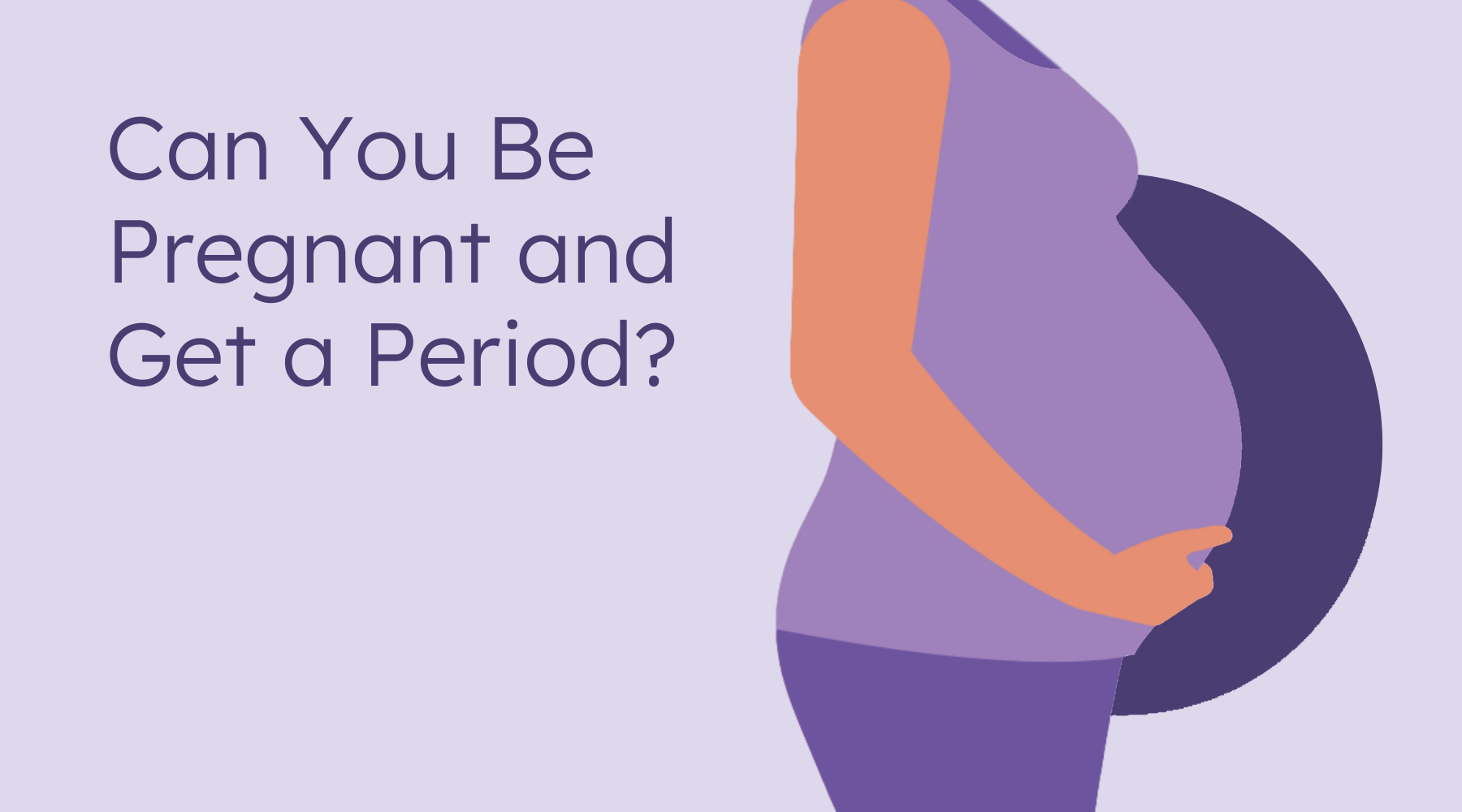Trigger alert: This article will discuss miscarriage.
No, you can’t be pregnant and menstruate at the same time.
What we commonly call a “period”, or menstruation, is the shedding of the lining of the uterus that occurs about two weeks after ovulation because pregnancy did not occur.
If you’ve had a positive home pregnancy test and are experiencing bleeding, it’s not menstruation but some other type of bleeding that deserves medical attention.
If you want to learn more about menstruation vs other types of bleeding that may occur when you know you are not pregnant, click here.
What can cause bleeding during the first trimester?
Bleeding during the first 12 weeks of pregnancy (ie 1st trimester) is actually pretty common. Up to 40 percent of pregnant women experience it and the most common causes are: implantation, infection, threatened or inevitable miscarriage, molar pregnancy, and ectopic pregnancy. Let’s unpack these one by one.

1. Implantation bleeding
Perhaps the most common causes of bleeding in early pregnancy, this type of light bleeding is due to the burrowing of the blastocyst into your uterine lining. Up to 10 percent of first time expectant moms have implantation bleeding while up to 25 percent of women who’ve been pregnant before will have implantation bleeding about 6 to 12 days after ovulation subsequent conception. The timing of implantation bleeding a week or so after conception means it’s often mistaken for a menstrual period, especially if the woman is not in the habit of tracking her fertility or is used to very light periods.
If you think you are having implantation bleeding and have not taken a pregnancy test your best next step is to take a test.
You can read more about implantation bleeding here.
2. Infection
If you have contracted a sexually transmitted infection such as chlamydia or gonorrhea, your cervix or vagina may bleed during early pregnancy. See your doctor for any appropriate treatment and monitoring to ensure your health and the health of your baby.
3. Miscarriage
If you have confirmed that you are pregnant, any bleeding can be thought of as a threatened miscarriage also termed threatened spontaneous abortion. This term means that loss of the pregnancy is possible but not for sure.
An OB/GYN will be able to assess the risk of a loss and discuss any options for trying to prevent the loss. Bed rest is the most common recommendation for threatened miscarriage however new research shows that progesterone therapy may help women who’ve had miscarriages before. In their risk assessment, your doctor will look at your cervix to determine if the miscarriage is imminent because, unfortunately, the cervix has begun to open.
As difficult as it is to experience, miscarriage, also known as spontaneous abortion, is a natural process that is thought to occur because there were abnormalities that would have prevented normal development and survival of the child.
The hardship of recurrent miscarriage actually spurred Proov’s founder, Amy Beckley, to develop an in-home test for progesterone after she learned that she had low levels of this hormone that helps sustain a pregnancy. Read about her amazing story here.

4. Molar pregnancy
This unfortunate outcome happens when a sperm fertilizes an empty egg. The result is a rise in the pregnancy hormone, hCG, and formation of the placenta but, sadly, there is no baby. Vaginal bleeding is one symptom of a molar pregnancy. If your doctor suspects a molar pregnancy, he or she will order blood work and an ultrasound. You can learn more about molar pregnancy here.
5. Ectopic pregnancy
Implantation that occurs outside of the uterus results in the life-threatening event of an ectopic pregnancy. The most common erroneous site of implantation is somewhere in the Fallopian tube but ectopics can also occur in the cervix or ovary. The pregnancy can not continue and, unfortunately, the new life needs to be surgically removed to protect the mother. Early warning signs of an ectopic pregnancy include pelvic pain and vaginal bleeding. If the bleeding is coming from your fallopian tube, you may also feel shoulder pain or the urge to have a bowel movement.
Risk of an ectopic is one of many important reasons to see a doctor if you think you are pregnant, know you are pregnant — and are experiencing bleeding.
What can cause bleeding during the second and third trimesters?
After the 12th week of pregnancy, miscarriage is still a possibility if you experience bleeding. In addition to possible miscarriage, in the last 6 months of pregnancy bleeding may be a sign of other issues that warrant medical attention. These include:
Incompetent cervix
The cervix is the opening to your uterus and has the important job of sealing up and staying shut to keep the baby in until it’s time to deliver. If you are having light bleeding after the 3rd month of pregnancy, it may be because your cervix has begun to open before it is time to give birth. In addition to bleeding, you may have cramps, a new backache, or unusual vaginal discharge. See your doctor who can assess if this is the reason for your bleeding.

What should I do if I experience bleeding during pregnancy?
Contact your doctor. This is not to be alarmist but your care provider needs to know about any bleeding that occurs during pregnancy to ensure that you and your baby are healthy. It's important to investigate the cause of the bleeding and rule out the life-threatening possibility of an ectopic pregnancy.
Anxious thoughts may whirl about in your head as you learn more about your bleeding. That's totally understandable because you don't know what's going on with your body. If a miscarriage is the cause of your bleeding, please know — you did not cause it. If you are thinking of trying to become pregnant again, please read this helpful article.












